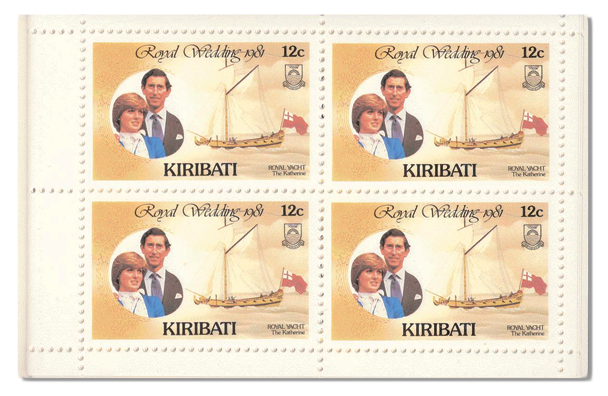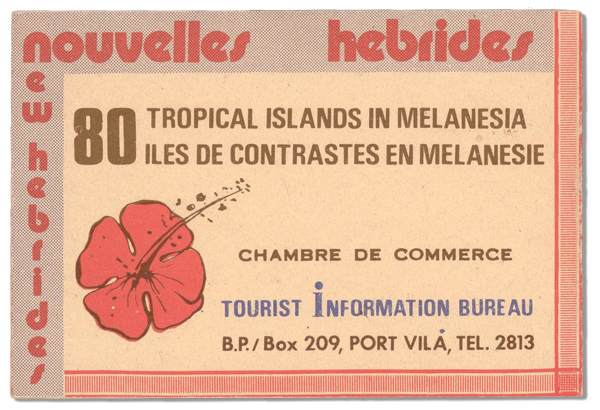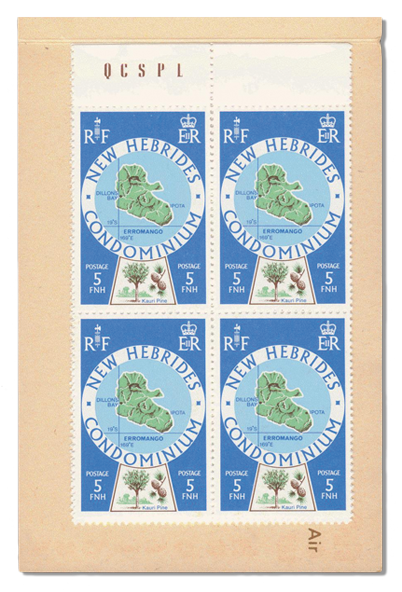Where did the Gilbert and Ellice Islands go? They’re gone. I can’t find them on current maps. I can’t find them in travel books. They’re in my stamp album and they’re in my stamp catalogue. So they must be someplace, or did they sink into the ocean? The Scott catalogue says that the Gilbert and Ellice Islands were replaced by the Gilbert Islands and Tuvalu on January 1, 1976. The catalogue further states that, “Gilbert Islands stamps were replaced in 1979 by those of Kiribati.”
Figure 1 (above right) The Republic of Kiribati honors the Royal Wedding of H. R. H. Prince Charles and Lady Diana.
There’s a clue. Checking the internet for Kiribati I found that the country obtained its independence in 1979. When the islands achieved their independence they became The Republic of Kiribati (pronounced Kiribas).The Gilbert and Ellice Islands was a British protectorate since 1892 and became a colony in 1916. Despite the fact that it was a colony, the islands were mainly self-governing and were basically left to themselves by the British colony and administration system.
During World War II, the Japanese occupied Tarawa (the capital) and threatened to rule over the islands. There were very strong ties to Great Britain. The Japanese did nothing to endear the Gilbertese to wish to succumb to Japanese rule. The Gilbertese did what they could to see that the Japanese occupation was thwarted.
There is an island in the Republic of Kiribati called Kiritimati or Christmas Island. The “ti” is pronounced “s” so this island is “kee-rees-mas.” (This Christmas Island is not the stamp issuing entity in the Indian Ocean which is a territory of Australia.) In 2003 Kiribati issued a set of stamps (Scott 837-841a) showing scenes around the Pacific Christmas Island. Unlike Tuvalu, Kiribati has only issued stamps in the name of the Republic of Kiribati whereas in Tuvalu the eight individual islands have issued their own stamps.
Though independent, Kiribati issues many stamps that show their historical connection to Great Britain. Figure 1 is a picture of a stamp booklet issued in honor of the Royal Wedding of H. R. H Prince Charles to Lady Diana Spencer.
In 1999 two uninhabited islets were lost to the rising ocean. Predictions vary about the effects of global warming. Some people deny that the planet is getting warmer, but they can’t refute the fact that glaciers are melting and some are disappearing, Estimates are that the ocean will rise from half to one metre within the next 50 to 100 years. That is quite serious. Some islands will be submerged. All of the islands will lose land area.
While finding the temporarily lost Gilbert Islands (renamed Kiribati) as a result of independence, I came across the Tuvalu Islands, which used to be the Ellice Islands. Tuvalu is the fourth smallest nation in the world (26 km²). Sales of stamps and coins form a large part of government revenues. There are eight inhabited islands: each one has issued stamp booklets.
These islands are also disappearing and will be lost – either submerged or become uninhabitable. Global warming and the rising ocean seem to be the main, but not the only, reason. The highest point on any of the islands is about five metres. Most of the islands’ surfaces are about two meters above sea level. The population (over 11,000) has doubled since 1980, taxing the already scarce potable water. Storms are fiercer and more frequent than ever before. Sea-water has been surging through the land areas causing the freshwater to become brackish. One island can no longer support the growth of coconut trees because of salination. On the days between storms, droughts have become more severe.
In 1974 Tuvalu separated from the Gilbert Islands but remained a British dependency. In October 1978 Tuvalu achieved full independence. Today it is a constitutional monarchy and a member of the Commonwealth of Nations that recognize Queen Elizabeth II as their Queen and head of state. The ties to Great Britain can be seen on the stamps of Tuvalu. For a few years after independence, the stamps bore the crest “E R II surmounted by a crown”, but that stopped in November 1981.
Tuvalu has issued over 1,000 different stamps including postage due and officials since 1971. That is only part of the story. Each of the eight islands has issued its own stamps accounting for over six hundred additional stamps since 1984. The stamps commemorate events and people from around the world including World War II, H. R. H. Queen Victoria, World Cup Soccer Championships, World Scout Jamboree and, for some reason, Norman Rockwell’s paintings.
An interesting set of booklets was issued for the Royal Wedding of 1986, H. R. H. Prince Andrew and Miss Sarah Ferguson. There are eighteen booklets, a pair for Tuvalu and a pair for each of the eight islands. The covers of the booklets have two designs, nine of the Royal coach and nine showing Westminster Abbey (see Figure 2). The words and pictures inside the booklets are 95% similar. The stamps have different designs. The stamps in the nine booklets with the Royal Coach cover are imperforate indicating that the Postal Authority doesn’t expect anyone to explode the booklet, cut the stamps apart, and use them for postage. They are revenue producers.
Figure 2 – Front Cover of booklet honoring the marriage of H. R. H. Prince Andrew and Miss Sarah Ferguson
Figure 3 – Back cover from New Hebrides Condominium
Unlike the previous islands, the New Hebrides has great elevations and lush vegetation. The highest point is over 4,700 feet. These islands were formed through volcanic action rather than as coral reefs. However, like the Gilbert and Ellice Islands, the New Hebrides achieved independence in 1980 and became the country of Vanuatu. Independence in this case meant independence from two countries, Great Britain and France. The New Hebrides (also known as the Nouvelles Hebrides) had a condominium form of government being administered by both countries. Figure 3 shows the back cover of a stamp booklet from New Hebrides which is printed in French and English. Figure 4 shows the stamps inside the booklet with the French “R F” and the “E R II” crests. The words New Hebrides Condominium are very prominent. The stamps are Scott 238, 239, and 240. Independence occurred on July 30, 1980 and on that day, new stamps were issued. They were the same as the ones shown in Figure 4 but the crests were removed; the words New Hebrides Condominium being replaced with the new country name of Vanuatu. A stamp of similar design in French was issued simultaneously (Scott Vanuatu 280 – 292 in English and 280a – 292a in French). This practice of issuing stamps in both English and French continued for about three months, but stopped in September 1980. Even though the stamps did not bear any French words, Figure 5 shows that the booklet covers were printed bilingually. The stamps in this Vanuatu booklet are blocks of 4 of fish (Scott numbers 443, 444, 448, and 449).
Figure 4 – Last stamps issued before independence of New Hebrides from booklet of Figure 3
Figure 5 – Booklet from Vanuatu (formerly New Hebrides). The stamps shows no French but the inside front cover of the booklet is bilingual.
The Condominium form of government is rather unusual since only about a dozen have been formed in the past three centuries. Condominiums (or is it Condominia? Both are used in Wikipedia) have occurred all around the globe but seem to have been limited to islands, lakes, rivers, cities, and small principalities. Andorra is an example of an existing Condominia.
Besides the New Hebrides, another Condominium occurred in Oceania on the coral atolls of Canton and Enderbury. Canton is mostly lagoon and Enderbury is mostly dry land. Very little grows there. Both islands were claimed by the United States and Great Britain. In 1938 both countries agreed to put the question of sovereignty aside and to use the islands together to promote commercial aviation and communication. The lagoon of Canton Island provides one of the best seaplane bases in the Pacific. This allows for a replenishing and refueling point and thus provides excellent air and naval communications to the Philippines, Australia, New Zealand, and other Pacific countries. From 1939 until 1979 these islands formed a British – American condominium. After that they became part of the Republic of Kiribati.
The islands are barren and almost at sea level. With global warming, they will probably be washed over by the ocean and lost except to the geography and history books. Since they are currently uninhabited, there are those who would consider them already gone.
You may wish to seek further information about some of these islands and the forms of government mentioned above on the internet. Searching on the names of the islands will yield historical information as well as travel data. When looking for citations about the condominium form of government the search words “condominium international law” are better than “condominium government.” Searching with “government” in the search field yielded over 4½ million citations. When “international law” was included in the search field there are over 4 million citations using one search engine and about 500,000 using another. Not a big improvement. When searching on the exact phrase “condominium international law” five citations emerged. They are enough to obtain a reasonable understanding of what condominium means when two or three countries claim jurisdiction over the same territory and manage to administer it cooperatively and peacefully. The fact that there have been so few condominiums is testimony to the inability of countries to be willing to share sovereignty for their common good.












Leave A Comment
You must be logged in to post a comment.